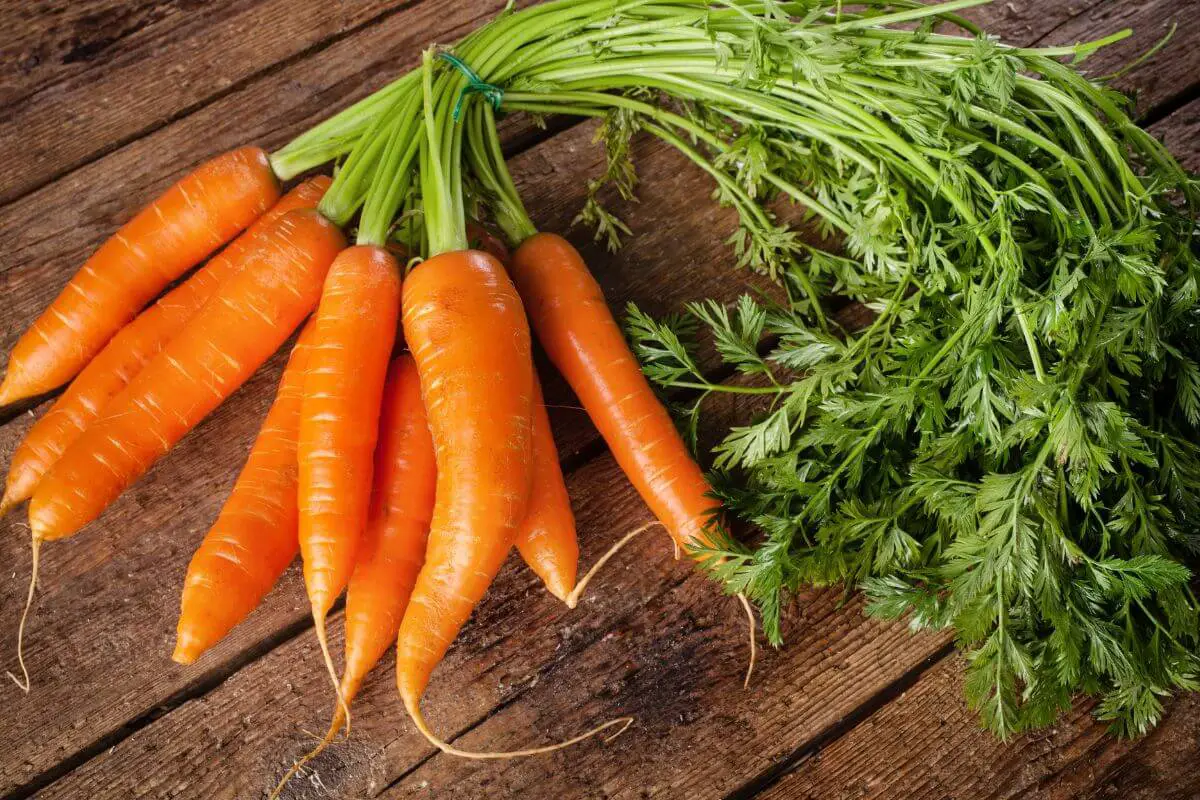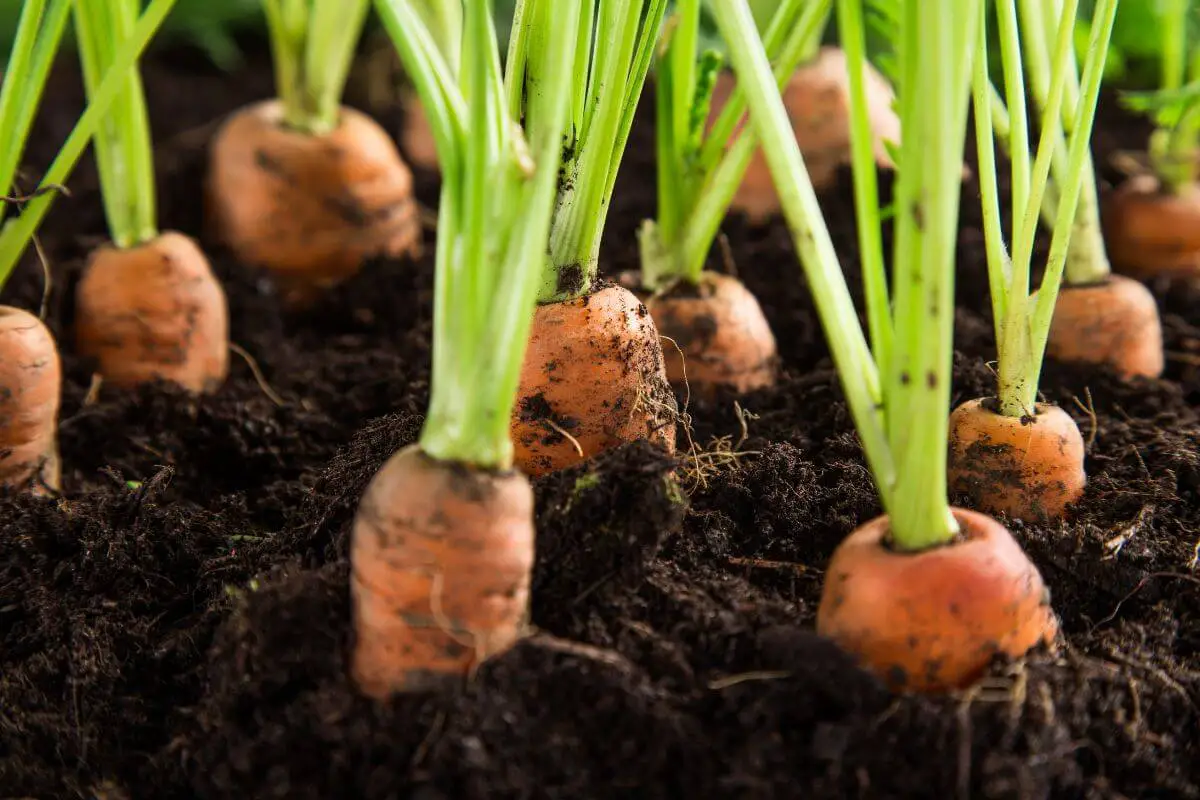Have you ever wondered, “Is a carrot a fruit or vegetable?” It’s a common question that can stump even the most seasoned gardeners and cooks. Carrots are a staple in our kitchens, but their classification can be puzzling.
I’ll dive into the botanical and culinary classifications of carrots. You’ll learn why botanists and chefs both agree that carrots are vegetables. I’ll also explore how carrots grow, their health benefits, and some interesting facts you might not know.
Curious to find out more about this versatile root? Keep reading to uncover the true nature of carrots and why they belong in your vegetable drawer.
- Related article: Fruit and Vegetable Difference
5 Key Takeaways on Is Carrot a Fruit or Vegetable
- Carrots are veggies in both the botanical and culinary worlds. Botanically, they are root vegetables. They don’t grow from flowers and don’t have seeds. In cooking, we use them in savory dishes, not sweet ones.
- Carrots grow over two years. In the first year, they grow the part we eat, the taproot. If you leave them in the ground, they will flower and make seeds in the second year.
- Most people harvest carrots in the first year. This way, they get the tasty roots before the plants flower and seed.
- If you want carrot seeds, leave some in the ground. Wait until they flower and the flower clusters turn brown. One carrot plant can give you thousands of seeds.
- Carrots are super healthy. They have beta-carotene, vitamin K, potassium, and fiber. They help your eyes, boost your immune system, and aid in weight loss and digestion.
Is Carrot a Fruit or Vegetable?

Carrots are a type of vegetable. They grow underground as root vegetables. This part of the carrot plant is what we eat.
We usually classify fruits and vegetables in two ways: botanical and culinary. Carrots fit both classifications as a vegetable.
We classify foods by their botanical identity or how we use them in cooking. Sometimes, these definitions do not match up.
Tomatoes are a good example of this conflict. Botanists say tomatoes are fruits. Chefs call them vegetables. So, who’s right?
In botany, tomatoes are fruits because they develop from the flower and contain seeds. But chefs call them vegetables because of how they are used in many dishes.
- Learn more: Are Tomatoes Fruits or Vegetables?
Why Are Carrots Vegetables?
Botany says a vegetable is any part of a plant we can eat that doesn’t grow from the flower and has no seeds. A fruit develops from the flower’s ovary and has seeds for the plant’s reproduction.
When we look at it botanically, carrots are vegetables. The part we eat is the taproot that grows underground. It doesn’t come from a flower and has no seeds, so it fits the vegetable definition.
In cooking, carrots are also vegetables. They aren’t sweet and are used in side and main dishes. Fruits are sweet and usually found in desserts. So, carrots are vegetables both in botany and in the kitchen.
What to Know About Carrot Seed Production and Harvesting
Carrot seeds are essential for growing new carrot plants. Here’s a summary of how they are produced and harvested:
| Aspect | Description |
|---|---|
| Location of Seeds | Carrot seeds are found in the flowers of the plant. |
| Blooming Cycle | Carrots bloom in their second year of growth as biennial plants. |
| Common Harvesting | Most carrots are harvested in their first year for their edible roots, preventing them from flowering. |
| Seed Production Process | To get seeds, leave some carrots in the ground until they flower. Harvest seeds when the flower clusters brown. |
| Flower Development | The green tops grow into flowers that produce seeds if left to mature. |
| Seed Quantity | One plant can produce 1,000 to 8,000 seeds, with many seeds in each flower stalk. |
Growth Cycle of Carrot Plants

Carrots, or Daucus carota, have a two-year growth cycle. They are biennial plants.
In the first year, you plant the carrot seeds. These seeds have the plant’s genetic material. They germinate and send up a stem with a true leaf. The main root, called a radicle, grows down into the soil.
The leaf is vital for the plant. It helps the plant photosynthesize. This process ensures the plant gets the nutrition it needs to grow.
Next, the carrot plant develops its taproot. This taproot is the carrot we eat. You can harvest these taproots after about 75 to 80 days, depending on the carrot variety.
As the plant grows, more true leaves appear. The taproot also keeps growing. If you harvest the carrots, the plant’s growth stops here.
If you don’t harvest the carrot, the tops die back after the first frost. The plant enters dormancy.
In spring, the leaves and stems grow again. The plant will flower and produce tiny white blooms.
When the flower dies and dries, the seeds fall when the stem moves. One carrot plant can produce up to 10,000 seeds.
After flowering, carrots become woody and lose flavor. So, it’s best to harvest them at the end of the first year.
What Are the Health Benefits of Carrots?

Carrots are rich in antioxidants, and as a result, offer multiple health benefits when consumed.
Some of their more well-known benefits include:
1. Carrots Help Keep Bones Healthy
Carrots have vitamin K and calcium. These nutrients help keep your bones healthy.
But saying carrots protect bones isn’t backed by science. Bone health depends on many things. You need calcium and vitamin D. You also need to stay active and eat well. Carrots have some vitamins and minerals but not enough calcium or vitamin D for strong bones.
2. Carrots Improve Eye Health
The beta carotene in carrots helps boost eye health. Orange carrots are especially high in this. Beta-carotene turns into vitamin A in your body. Vitamin A helps keep your eyes healthy. It can lower the risk of cataracts and protect your eyes from sun damage.
Carrots also have lutein. Lutein can help prevent age-related macular degeneration.
Vitamin A in carrots is important for eye health. It keeps the retina and other parts of the eye healthy. But eating carrots or foods rich in vitamin A won’t improve vision beyond normal if you already have enough vitamin A.
3. Carrots May Help Boost Heart Health
Carrots can be great for your heart. They have potassium that helps control blood pressure. This helps lower the risk of heart disease.
Carrots are packed with vitamins, minerals, and antioxidants. But, eating only carrots won’t make your heart healthier. You need a balanced diet, regular exercise, and a healthy lifestyle to keep your heart strong.
4. Carrots Help Boost the Immune System
Carrots have vitamin C. This helps make antibodies to protect your immune system. Vitamin C also helps your body absorb iron. This is important to stop infections.
All these compounds in carrots support your immunity, heart, kidney, and liver health. They are also low in calories and make great snacks.
5. Carrots Help Provide Constipation Relief

Feeling blocked up from too much junk food? Raw carrots might help. They have lots of fiber that can get your digestive system moving again.
When babies start eating solid foods, they might get constipated. Here are some tips to help:
- Offer water after meals.
- Give them fiber-rich foods like pears and mashed carrots.
- Adjust the amount of solid food they eat.
To ease constipation, try these changes:
- Eat carrots and other fiber-rich foods.
- Drink lots of water.
- Use healthy oils like olive, coconut, or avocado oil.
These tips can help keep your digestive system running smoothly.
Remember that carrots affect everyone differently. Some people say carrots make them constipated. Raw veggies like carrots can be tough on your stomach and might cause blockages. Always pay attention to how carrots affect your digestion.
6. Carrots Help Control Blood Sugar Levels
If you have diabetes, eating non-starchy vegetables is a must. Carrots are a great choice. The fiber in carrots helps keep blood sugar steady. There’s also some evidence that beta-carotene and vitamin A in carrots can lower diabetes risk.
Carrots can affect blood sugar differently based on how much you eat, how you cook them, and your metabolism. They have a moderate glycemic index (GI) of about 40. This means they raise blood sugar slower than high-GI foods. But everyone’s body reacts differently to foods.
7. Carrots Aid in Weight Loss

Carrots help with weight loss because they have few calories and lots of fiber. The fiber makes you feel full so you eat less. This helps you eat fewer calories. Carrots also have nutrients like beta-carotene, vitamin K1, and potassium. These nutrients are good for your health.
8. Carrots May Help Lower Blood Cholesterol
Carrots can help you lose weight because they are low in calories and high in fiber. The fiber makes you feel full so you eat less and can create a calorie deficit. Carrots also have nutrients like beta-carotene, vitamin K1, and potassium. These nutrients are good for your overall health.
9. Carrots May Reduce Risk of Cancer
Eating fruits and veggies like carrots can help lower the risk of some cancers. But they don’t have enough of the good stuff to treat cancer.
Antioxidants in carrots fight free radicals in your body and might help reduce cancer risk.
Diet and cancer prevention is tricky. Many things work together in your diet and life. Be careful with claims about foods preventing or treating cancer. Always think about your overall lifestyle and listen to medical advice.
Different Ways to Prepare Carrots

Carrots are awesome vegetables used in many dishes. You can eat them as a side dish in different ways: roaster, sautéed, or steamed. You might cook them in butter or olive oil based on your taste.
Carrots are also common in casseroles, curries, salads, soups, stews, and pasta dishes.
Raw carrots are great in salads and as snacks. They are excellent with dips, dressings, or hummus.
You can use carrots in smoothies and juice, which is great because they pack a lot of vitamins and pectin (fiber in carrots).
If you love sweets, try carrot cake or muffins. They add a healthy twist to desserts.
Here are some ways to enjoy your carrots:
- Mashed carrots with butter, salt, pepper, and herbs
- Shredded raw carrot salad with lemon juice and olive oil vinaigrette
- Carrot fries baked or air-fried with olive oil
- Carrot soup with various recipes online
- Roasted carrots with seasonings like honey, butter, tarragon, cinnamon, or brown sugar
- Steamed carrots for a healthy choice
- Grated carrot salad with dressings and add-ins like raisins or harissa feta
- Carrot cake as a classic dessert
Baby carrots are a popular snack. There are two kinds:
- Whole carrots harvested small
- Baby-cut carrots from larger carrots, machine-cut, peeled, polished, and sometimes washed in chlorine
Both types have similar nutrients and health benefits.
Store carrots in the vegetable drawer of your fridge. They last long and are versatile. If you have extra carrots, slice and steam them, roast them, or make carrot sticks for snacks. Grated carrots work well in stir-fries, soups, and salads. You can also freeze carrot soup to avoid waste.
What Are Some Interesting Carrot Facts
Did you know that the idea that carrots improve eyesight is a myth? This story started during World War II. The British army wanted to hide their use of radar, so they spread the myth that pilots had excellent night vision because they ate lots of carrots.
Carrots don’t grow in the wild. Farmers bred them selectively. Wild rabbits don’t eat carrots naturally either.
Eating too many carrots can turn your skin yellowish-orange. This happens because carrots are rich in beta-carotene. This condition is called carotenemia.
In Terry Pratchett’s Discworld series, there’s a character named Carrot. He is simple and knights Sam Vimes. Carrot also has unique grammar skills.
These facts show the different sides of carrots. They touch on history, myths, selective breeding, and even how they can change your skin color.
Carrots are Vegetables Final Thoughts
From a culinary and botanical definition, carrots are classified as vegetables. Carrots are one of the most versatile vegetables out there and work for a wide variety of cuisines.
They’re easy to grow, store, and prepare. They’re inexpensive, nutritious, and can be enjoyed raw or cooked.
For more articles on other vegetables and fruits, check out these articles:

